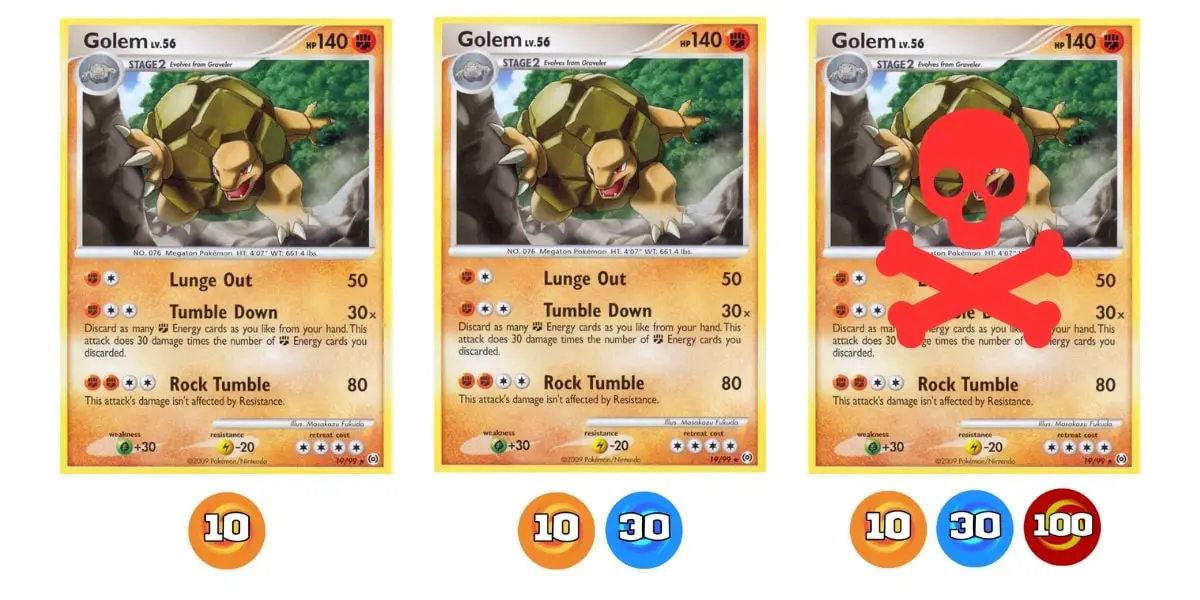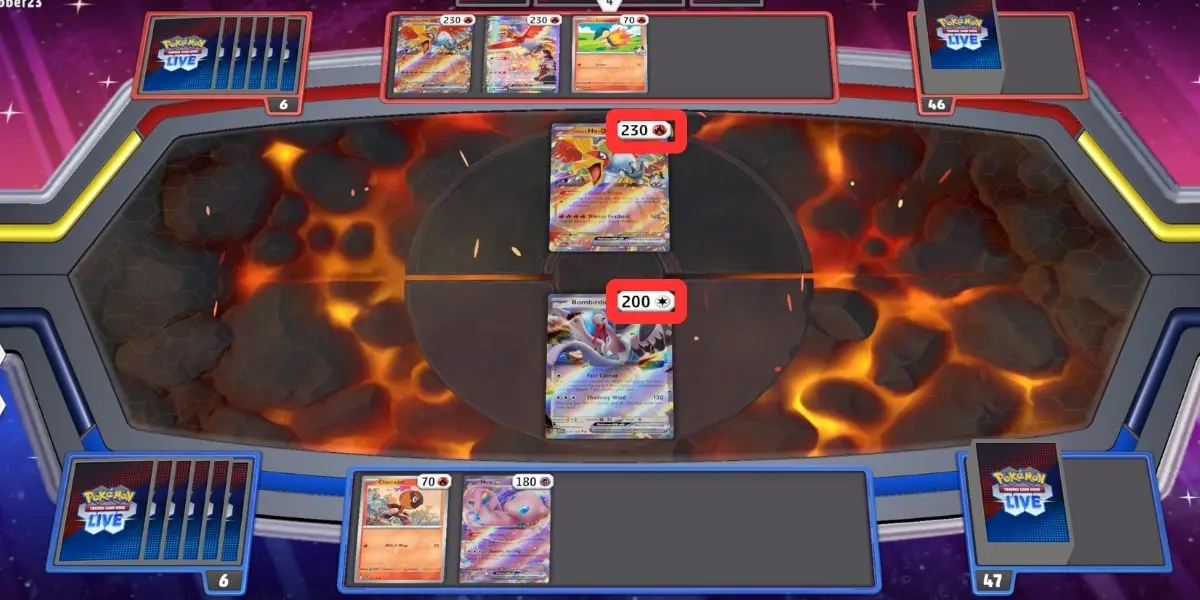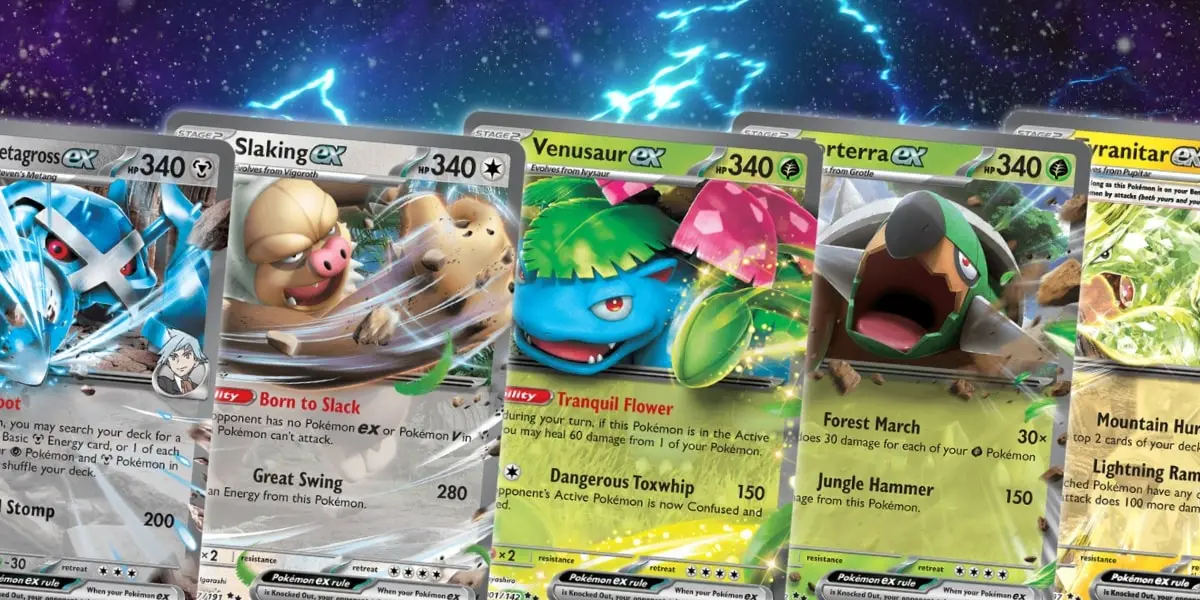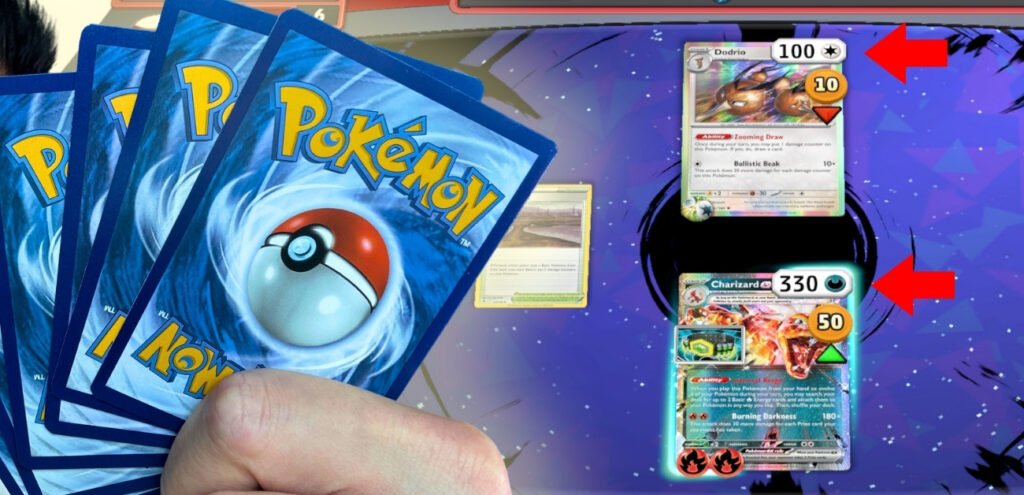HP (Hit Points) on a Pokémon card shows how much damage a Pokémon can take before it’s knocked out, discarded, and your opponent takes a Prize card. HP is important because it determines survival and overall strategy when creating a Pokémon deck.
This post may contain affiliate links. See our affiliate policy for more information.
HP in Pokémon cards isn’t just a stat. It’s your Pokémon’s lifeline. A mere 10 extra Hit Points can be the difference between a KO and a second chance to attack. So if you’re serious about playing the Pokémon card game, let’s get you fluent in one of the most basic mechanics: Pokémon card HP.
Key Takeaways
- Higher Pokémon card HP lets your Pokémon take more damage and stay on the field longer.
- Big HP is not always better. High-HP Pokémon ex, VSTAR, and VMAX are slower to set up and give up multiple prizes when KO’d, making them risky if knocked out early.
- When building a Pokémon deck, you need to balance a mix of tanky and low-HP Pokémon to maintain speed and flexibility.
- Learn how to build around Pokémon card HP to give you a strategic edge in playing the Pokémon TCG.
What Is HP In Pokémon Cards?

HP stands for Hit Points. It tells you how much damage your Pokémon can take before it gets knocked out and thrown in the discard pile.
Has your Pokémon taken equal or more damage than its HP? Your Pokémon is Knocked Out. Your opponent grabs a prize. And depending on what they KO’d, that could be one, two, or even three prize cards gone in one swing. That’s just how Prizes work in Pokémon cards!
Importance Of HP Margins

A 10 or 20 HP difference really matters in the Pokémon TCG. This is a game of margins, and more often than not, battles are decided by razor-thin math.
An attacker dealing 130 damage slams through a 120 HP Pokémon in one fell swoop- but it falls short of knocking out a 140 HP Pokémon. Congrats. You’ve just bought yourself an extra turn, and that gives you space to breathe.
What can you do with that extra turn? Retreat, evolve, or anything to pull off a counterattack and recuperate ground.
Furthermore, you’ll often see skilled players hanging on by the skin of their teeth. It’s not luck. It’s a testament to good deck-building and a firm understanding of the meta’s damage thresholds.
So when you’re creating a Pokémon deck, don’t just focus on attack damage- look at your Pokémon’s HP too.
Typical HP Values In Pokémon Cards
Let’s break down what’s considered “low” and “high” HP in the modern meta:
| HP Category | Typical Value | Usually Found On | Traits |
|---|---|---|---|
| Low | 30-90 HP | Basic Pokémon | Cute but fragile. They’re usually on the field for set up and get out. Easily one-hit KO’d in the mid to late game. |
| Medium-Low | 90-130 HP | Stage 1 | Slightly beefier. Still not invincible. They might be able to soak up 2 to 3 hits in the early game, but easily one-hit KO’d in the mid to late game. |
| Medium-High | 150-190 HP | Stage 2 | These are your evolved attackers. They can usually take 2 to 3 or more hits before being KO’d, depending on the attacker. |
| High | 180 to 340 HP | Pokémon ex, VSTAR, VMAX | Literal boss monsters. They can be Basic, Stage 1, or Stage 2. They’re the tankiest Pokémon cards in the game and usually take multiple hits to KO. |
HP Creep: The Rise of Hit Points
Once upon a time, 100 HP meant you were the King of the Playground. In 1999, Base Set Charizard had 120 HP, and it broke the minds of every 10-year-old collector.
But then came HP Creep:
- 2003 EX Era: Suddenly we had 130+ HP cards hitting shelves.
- 2013 XY Era: The HP ceiling hit a whopping 230.
- 2020 Sword & Shield Era: VMAX Pokémon said “hold my Pokéball” and the ceiling soared to 340 HP.
- 2024 Scarlet & Violet Era: Even Stage 2 single-prize (non-rulebox) Pokémon now sit comfortably at 150+ HP.
Why? Because Pokémon attacks escalated too. If HP didn’t scale up accordingly, every Pokémon would be knocked out turn after turn, and the game would become broken.
So if you’re holding two Charizards with completely different HP values… well, now you know why. They’re from different eras!
Highest HP Pokémon

The HP ceiling in the Pokémon TCG is currently capped at 340 HP. Here’s a list of the tankiest Pokémon in the current format:
| Steven’s Metagross ex | DRI 145 |
| Mamoswine ex | JTG 079 |
| Tyranitar ex | PRE 064 |
| Tyranitar ex | OBF 066 |
| Palafin ex | TWM 061 |
| Skeledirge ex | PAL 037 |
| Slaking ex | SSP 147 |
| Venusaur ex | SCR 001 |
| Garganacl ex | SCR 089 |
| Torterra ex | TEF 012 |
Is High HP Always Better?
High HP is usually a good thing. But not always- loading your board with tanks can be disastrous. Consider these precautions before releasing a tanky Pokémon:
1. High HP = Multi-Prize Liability
High HP Pokémon are usually rule-box Pokémon- ex, VSTAR, VMAX. These give your opponent 2 or 3 prizes when it’s KO’d. That means if your wall gets knocked out early, you might be halfway to losing. Meanwhile, someone using all single-prizers forces their opponent to work for every prize.
2. Tanks Are Slow To Set up
High HP Pokémon usually need multiple Energy to attack and often require 2 to 3 turns to evolve. If your draw engine fails or your Bench clogs? You’re stuck, your opponent is dishing out damage turn after turn, and your tanks turn into easy prize draws for your opponent.
3. High HP Pokémon Are Targets
You think you’re being smart by dropping a 340 HP beast? Dropping it too early gives your opponent time to prepare. They might search out a Boss’s Order for a gust, rendering your Pokémon unplayable. Or they might search for a Maximum Belt damage modifier to prepare for a counter.
Boom. Your tank is gone, they get 2 prizes, and you’re scrambling with nothing but a frail support Pokémon in the Active Spot.
4. Not All Tanks Hit Hard
Just because a Pokémon has 340 HP doesn’t mean it’s good. Looking at you, Wailord.
If your card hits for 30 damage after 5 Energy and three turns of setup, it’s not a threat- it’s a punching bag. HP alone doesn’t win battles. When you are putting together your deck, only include high-HP Pokémon if they fit into your overall win strategy.
Conclusion
Pokémon HP needs to be a part of your mental checklist if you’re serious about playing the game. Because every time a card hits the field, you should be asking:
- How many hits can this survive?
- What’s the damage ceiling given the board state?
- How easy is this to Knock Out and claim prizes?
Ultimately, you want your tanky Pokémon to be a threat…and not just a juicy, over-invested target.
FAQ
Kalam is a PTCG gameplay expert and content creator. He started playing and collecting Pokémon cards since 1996. When he’s not working, you can find him nerding out on Anime!
Ready To Level Up At PTCG?

